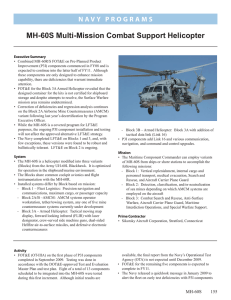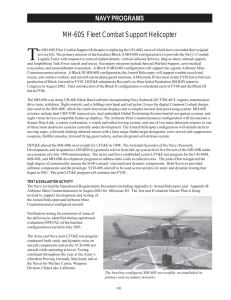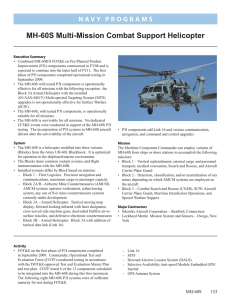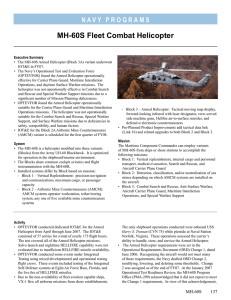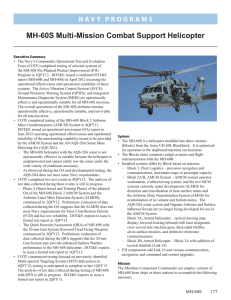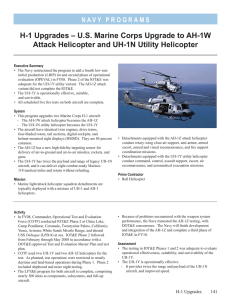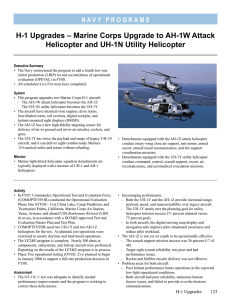MH-60S Block 3A Armed Helicopter Weapon System (AHWS)
advertisement
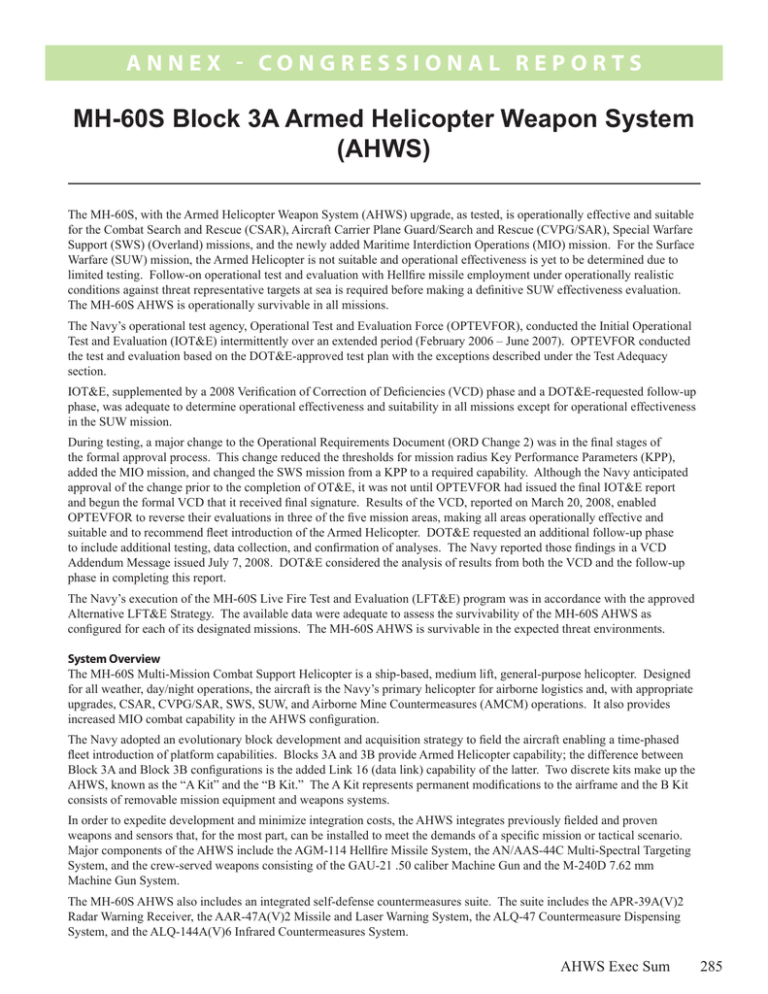
A nne x - congressional reports MH-60S Block 3A Armed Helicopter Weapon System (AHWS) The MH-60S, with the Armed Helicopter Weapon System (AHWS) upgrade, as tested, is operationally effective and suitable for the Combat Search and Rescue (CSAR), Aircraft Carrier Plane Guard/Search and Rescue (CVPG/SAR), Special Warfare Support (SWS) (Overland) missions, and the newly added Maritime Interdiction Operations (MIO) mission. For the Surface Warfare (SUW) mission, the Armed Helicopter is not suitable and operational effectiveness is yet to be determined due to limited testing. Follow-on operational test and evaluation with Hellfire missile employment under operationally realistic conditions against threat representative targets at sea is required before making a definitive SUW effectiveness evaluation. The MH-60S AHWS is operationally survivable in all missions. The Navy’s operational test agency, Operational Test and Evaluation Force (OPTEVFOR), conducted the Initial Operational Test and Evaluation (IOT&E) intermittently over an extended period (February 2006 – June 2007). OPTEVFOR conducted the test and evaluation based on the DOT&E-approved test plan with the exceptions described under the Test Adequacy section. IOT&E, supplemented by a 2008 Verification of Correction of Deficiencies (VCD) phase and a DOT&E-requested follow-up phase, was adequate to determine operational effectiveness and suitability in all missions except for operational effectiveness in the SUW mission. During testing, a major change to the Operational Requirements Document (ORD Change 2) was in the final stages of the formal approval process. This change reduced the thresholds for mission radius Key Performance Parameters (KPP), added the MIO mission, and changed the SWS mission from a KPP to a required capability. Although the Navy anticipated approval of the change prior to the completion of OT&E, it was not until OPTEVFOR had issued the final IOT&E report and begun the formal VCD that it received final signature. Results of the VCD, reported on March 20, 2008, enabled OPTEVFOR to reverse their evaluations in three of the five mission areas, making all areas operationally effective and suitable and to recommend fleet introduction of the Armed Helicopter. DOT&E requested an additional follow-up phase to include additional testing, data collection, and confirmation of analyses. The Navy reported those findings in a VCD Addendum Message issued July 7, 2008. DOT&E considered the analysis of results from both the VCD and the follow-up phase in completing this report. The Navy’s execution of the MH-60S Live Fire Test and Evaluation (LFT&E) program was in accordance with the approved Alternative LFT&E Strategy. The available data were adequate to assess the survivability of the MH-60S AHWS as configured for each of its designated missions. The MH-60S AHWS is survivable in the expected threat environments. System Overview The MH-60S Multi-Mission Combat Support Helicopter is a ship-based, medium lift, general-purpose helicopter. Designed for all weather, day/night operations, the aircraft is the Navy’s primary helicopter for airborne logistics and, with appropriate upgrades, CSAR, CVPG/SAR, SWS, SUW, and Airborne Mine Countermeasures (AMCM) operations. It also provides increased MIO combat capability in the AHWS configuration. The Navy adopted an evolutionary block development and acquisition strategy to field the aircraft enabling a time-phased fleet introduction of platform capabilities. Blocks 3A and 3B provide Armed Helicopter capability; the difference between Block 3A and Block 3B configurations is the added Link 16 (data link) capability of the latter. Two discrete kits make up the AHWS, known as the “A Kit” and the “B Kit.” The A Kit represents permanent modifications to the airframe and the B Kit consists of removable mission equipment and weapons systems. In order to expedite development and minimize integration costs, the AHWS integrates previously fielded and proven weapons and sensors that, for the most part, can be installed to meet the demands of a specific mission or tactical scenario. Major components of the AHWS include the AGM-114 Hellfire Missile System, the AN/AAS-44C Multi-Spectral Targeting System, and the crew-served weapons consisting of the GAU-21 .50 caliber Machine Gun and the M-240D 7.62 mm Machine Gun System. The MH-60S AHWS also includes an integrated self-defense countermeasures suite. The suite includes the APR-39A(V)2 Radar Warning Receiver, the AAR-47A(V)2 Missile and Laser Warning System, the ALQ-47 Countermeasure Dispensing System, and the ALQ-144A(V)6 Infrared Countermeasures System. AHWS Exec Sum 285 A nne x - congressional reports Test Adequacy As a result of real-world operational commitments, testing did not include ship-based helicopter operations at sea. However, testing (IOT&E, VCD phase, and follow-up phase) was adequate to determine operational effectiveness and suitability in all missions except for operational effectiveness in the SUW mission. With the notable exception of not operating from an aircraft carrier at sea as well as other exceptions explained further in the report body, fleet personnel operated and maintained the MH-60S in the intended operating environment. The execution of the MH-60S LFT&E program was in accordance with the approved Alternative LFT&E Strategy contained in the Test and Evaluation Master Plan. The available data were adequate to assess the survivability of the MH-60S in its baseline configuration missions. Operational Effectiveness The MH-60S AHWS is operationally effective for the CSAR, CVPG/SAR, SWS (Overland), and MIO mission areas. Its operational effectiveness in the SUW mission is undetermined as a result of insufficient Hellfire missile firings, the lack of threat-representative targets at sea, no firings during darkness, and no multiple missile shots at rapid rates of fire. Despite numerous identified deficiencies, the AHWS Mission Planning System (MPS) had sufficient utility to support mission accomplishment based on the mitigating actions outlined in the VCD addendum. For SUW, the Hellfire testing was inadequate with only three developmental test/operational test missile shots, all against non-evasive targets and fired well short of the 4 nautical mile engagement range (standoff range to avoid manned portable air defense attack from the threat boat). Additionally, there were no nighttime or rapid rate of fire shots and excessive crew workload also affected Hellfire effectiveness. For CSAR, although ORD Change 2 reduced the requirement for the number of transportable survivors from four to two, there is still only room for one litter in the cabin. CVPG is a legacy mission executable by other aircraft and by itself does not justify AHWS. The intent of the test was to demonstrate that AHWS does not degrade the capability. In the MIO mission area, the use of legacy fast-rope equipment negatively impacted effective deployment and crew safety, but does not preclude the AHWS from satisfactorily completing the mission. Compared to the legacy HH-60H armed helicopter, the MH-60S AHWS provides a second cabin door, significantly improved targeting system, and additional firepower. Operational Suitability The MH-60S AHWS is operationally suitable for the CSAR, CVPG/SAR, SWS, and MIO mission areas. It is not operationally suitable for the SUW mission because of significant safety, human factors, and compatibility deficiencies. The MH-60S AWHS has safety, human factor, and compatibility deficiencies for all missions, most arising from the overcrowded cabin. While configured for SUW, all of the AWHS components are installed and present an even greater challenge for the crew to safely operate the aircraft and complete the mission. Following the IOT&E, multiple Naval Air Systems Command (NAVAIR) Safety Action Records (SAR), used to support Naval Aviation Training and Operating Procedures Standard (NATOPS) changes and warnings, mitigated these deficiencies, but did not correct the material problems. Although these administrative resolutions are acceptable in the Navy to consider the aircraft safe, they really only address the symptoms and not the causes. Operational Survivability The MH-60S AHWS is operationally survivable in most threat environments. Its design is a derivative of the Army’s Black Hawk helicopter, which has demonstrated survivability in combat. The MH-60S AHWS includes many features designed to avoid threat engagements such as signature reduction of the engine exhaust, an integrated self-defense countermeasures suite, threat suppression weapons, and situational awareness improvements. The aircraft is also ballistically tolerant against expected small arms threats and can continue to fly in spite of damage to many dynamic components. Recommendations The Navy should address the following issues and verify correction of deficiencies during follow-on OT&E: • Determine CV(N) shipboard compatibility of MH-60S AHWS under operationally realistic conditions. Testing should include underway flight operations with a representative complement of all air wing aircraft embarked. It should specifically address armed aircraft handling and servicing, arming and de-arming, alert launches, and aircraft stowage on both the flight and hangar decks. 286 AHWS Exec Sum A nne x - congressional reports • Determine operational effectiveness of AHWS in the SUW mission to include sufficient day and night overwater Hellfire missile firings to fully demonstrate the aircraft’s ability to conduct attacks against threat-representative, evasively maneuvering, seaborne targets from all weapon stations at tactical ranges. • Correct the safety and compatibility deficiencies through redesign in addition to procedural efforts where appropriate. • Correct human factors and mission planning deficiencies. • Redesign or reposition the gunner’s stroking seats to avoid injury during a crash. • Redesign the gunner’s belt system to prevent accidental release of the gunner’s belt when operating crew-served weapons. To further improve the suitability and survivability of the MH-60S AHWS, the Navy should consider the following: • Integrate the developed Mission Planning System (MPS) workarounds into NATOPS and implement into a training program that is available Fleet-wide to standardize these procedures until the Navy introduces an adequate replacement into the aircraft. • Development of a wireless internal communication system to mitigate entanglement issues. • Development of a safety interlock system to prevent the firing of a Hellfire missile unless the GAU-21 is locked in a safe position vice using challenge/reply checklist procedures alone. • Additional Hellfire missile exhaust testing with regard to potential health hazards to which the aircrew may be exposed. • Increase the number of ALE-47 Chaff/Flare dispensers. • Improve the APR-39A(V)2 Radar Warning Receiver. • Inert the fuel tanks to prevent fires and ullage reactions. • Reduce the potential for gearbox chip detector screen blockage resulting from ballistic impacts to the main transmission and input gearboxes. • Make necessary design changes in the main transmission to prevent cascading damage to the tail rotor drive system when impacted by ballistic threats. • Improve the engine bay fire detection and suppression system and redesign engine nacelle structural components to ensure that the nacelle door remains closed after ballistic impacts. • Incorporate dry bay fire protection in the tail boom and transition section. • Improve crashworthiness and emergency egress for situations where the aircraft is forced to land or crash into water. • Provide aircrew seats that are survivable and allow for sufficient space to provide a means for safe and effective aircraft egress. • Since the MH-60S AWHS operates at higher gross weights than the legacy UH-60M, the Navy should consider retesting the main transmission without oil for 30 minutes and crashworthiness with different weapons configurations (i.e., full complement of AGM-114 and GAU-21s deployed). AHWS Exec Sum 287 A nne x - congressional reports 288
